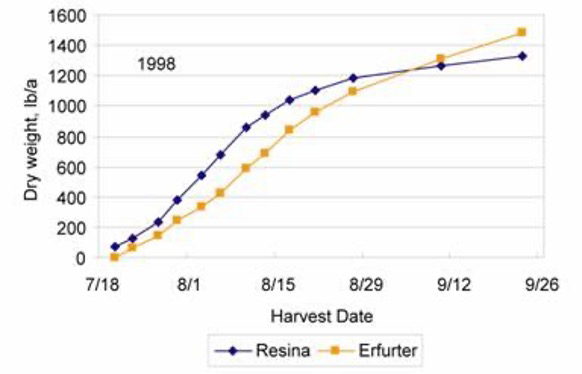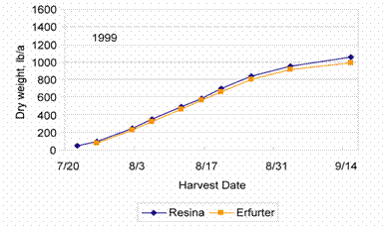Calendula
Nancy W. Callan, Mal P. Westcott, Susan Wall-MacLane, and James B. Miller
Background
Calendula (English marigold, pot marigold, Calendula officinalis L.) is an annual with bright yellow or orange daisy-like flowers. The flowers are harvested while in full bloom and dried for use as a medicinal or culinary herb. The entire flower heads or the petals alone are used. An industrial oil may be expressed from the seeds and an absolute oil is obtained from the flowers. Laying chickens may be fed orange calendula flowers to give the egg yolks a deep yellow color.
Calendula is fast-growing and easy to cultivate. It may be direct-seeded in the field and begins to flower in about two months. Harvest of calendula is time-consuming because the flowers form over a long period of time and individual flowers mature quickly. Over-mature flowers are undesirable in an herbal product. Frequent hand harvest is necessary to obtain the highest quality product, but some mechanization of harvest may be possible for a lower-grade product or for seed for industrial use.
Research summary
Two cultivars of calendula, 'Resina' and 'Erfurter Orangefarbige,' were direct-seeded on May 15, 1998, and May 18, 1999, at 5 lb/a in six-row plots 8 ft long, with rows 18" apart and four replications. Final stand of Resina was 3.3 (1998) and 4.6 (1999) plants/ft and of Erfurter Orangefarbige was 5.5 and 3.9 plants/ft. Flower heads were plucked from the plants by hand and air-dried out of direct sunlight. In 1998, flowers were harvested biweekly from July 20 through August 21, then weekly until September 23 (13 harvests). In 1999 flowers were harvested every 4-6 days (10 harvests) from July 22 (Resina) or July 28 (Erfurter) through September 3, with a final harvest September 15. Border rows were not harvested.
Resina began flowering a few days before Erfurter, but Erfurter continued to produce flowers slightly longer during the season (Fig. 1). The 1998 season was longer and warmer than in 1999, so a longer harvest period was possible. The cultivars did not differ in total yield (Table 1), so choice of cultivar would depend on market preference for flower color or other characteristics.
Figure 1. Cumulative harvest of 'Resina' and 'Erfurter Orangefarbige' calendula, 1998 and 1999, Western Agricultural Research Center


|
|
Dry weight (lb/a) ± SE
|
|
|---|---|---|
|
Cultivar
|
1998
|
1999
|
|
Resina
|
1,333 ± 91
|
1,051 ± 59
|
|
Erfurter Orangefarbige
|
1,485 ± 48
|
990 ± 117
|
The cultivars were not different by LSD (P=0.05)
Aster yellows
Aster yellows is a phytoplasma disease transmitted by leafhoppers. The disease causes stunting and malformation, particularly of the flowers, and renders the plant economically worthless. Both cultivars were susceptible to aster yellows, with up to 27% of the plants affected in 1999 (Table 2).
|
|
Plants with symptoms of aster yellows (%)
|
|
|---|---|---|
|
Cultivar
|
1998
|
1999
|
|
Resina
|
17 b
|
12
|
|
Erfurter Orangefarbige
|
11 a
|
27
|
|
P=
|
0.0493
|
0.0565
|
Mean separation by LSD (P=0.05)
Oil composition
The expressed oil of Erfurter Orangefarbige calendula was higher in calendic acid than that of Resina, with 54% for Erfurter vs. 49% for Resina. The difference between cultivars was significant (P=0.0019). The calendic acid content of oil from the two cultivars reported here is slightly lower than the mean of 62.8% reported for 12 calendula genotypes grown in Germany (1), but above the 47% average of 9 accessions grown in England (2). Oil content of the WARC seeds was not determined, nor was seed yield. For oil analysis, the oil was extracted into hexane followed by conversion of the triglycerides to the respective methyl esters. The relative fatty acid methyl ester percentages were then measured using gas-liquid chromatography.
Discussion
Calendula is a labor-intensive crop with a relatively small market for the flowers or flower petals. Flowers must be harvested regularly to avoid overmaturity, but the average harvest of calendula flowers in this study was only about 110 lb dry weight per acre. Mechanization of flower harvest is desirable. While the plant is generally easy to grow, aster yellows will limit its productivity in many locations, especially for the organic market.
Acknowledgements
Seed was provided by Johnny?s Selected Seeds, Albion, ME. Calendula seed oil analysis was performed by Dr. Jerry Bergman, MSU Eastern Agricultural Research Center, Sidney, MT.
References
- Beerentrup, H. and G. Robbelen. 1987. Calendula and Coriandrum - new potential oilcrops for industrial use. Fat Science Technology 89:227-230.
- Cromack, H. and J. Smith, 1998. Calendula officinalis - production potential and crop agronomy in southern England. Industrial Crops and Products 7:223-229.
- Hornok, L. 1992. Cultivation and Processing of Medicinal Plants. John Wiley and Sons, Chichester, UK.


